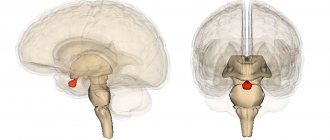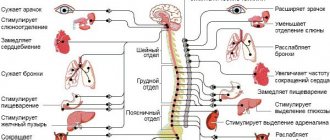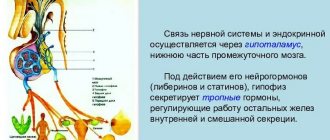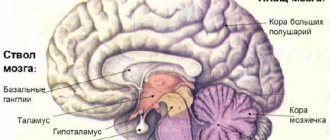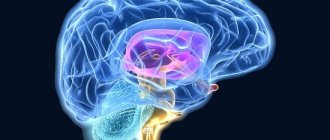Structures associated with the limbic system are located in the inner part of the temporal lobe of the brain: gyrus hippocampalis, which goes rostrally into the uncus and includes the amygdala and hippocampus, are involved in the regulation of the functions of the autonomic nervous system and the affective sphere. These areas of the brain are also credited with being responsible for drive and motivation, memory, and learning.
The limbic system of the brain is known to be associated with the emotional sphere of a person; its damage in schizophrenia is quite acceptable, given the mood swings, manic states, depression and agitation observed in this disease.
It is possible that in schizophrenia, not all components of the limbic system are affected equally, but more subtle morphological changes may occur in the structure of the neurons included in this system. Some, but distinct, of these changes have been found in some cases in patients suffering from bipolar affective disorder.
The results of many studies in schizophrenia show a decrease in the density of neurons in the hypothalamus, amygdala-hippocampus complex and parahippocampal gyrus.
The dimensions of the parahippocampal gyrus and entorhinal cortex, according to K. Prasad et al. (2004), find a certain correlation with the severity of delusions and psychotic symptoms in schizophrenia. According to researchers, these brain structures play an important role in regulating processes related to memory.
A reduction in size and change in the shape of neurons was found in the hippocampus, hippocampal gyrus and entorhinal cortex (Bogerts B., 1993).
Definition
The limbic system consists of a number of brain structures responsible for processing feelings and emotions to lead to new memories and bodily changes. It processes these stimuli as electrical signals throughout the central nervous system, allowing memory formation as well as autonomic and behavioral changes. Ultimately, the limbic system communicates with the endocrine system to allow the release of hormones so that the body can properly respond to presented stimuli.
How it works?
The limbic system spans multiple regions of the brain, and the full functionality of the system remains to be fully understood. Despite this, scientists have identified many structures that are important to the limbic system, such as the limbic lobe, hippocampal formation, amygdala, thalamus, and hypothalamus. These structures are able to communicate with each other, stimulating the individual cells of the structures, known as neurons. Eventually, connections are established between neurons that enable rapid processing from the initial stimulus to the final physical change.
Overview of the Nervous System
The nervous system is made up of individual nerve cells known as neurons, which are specialized in their ability to interact with electrical signals at speeds of up to 120 meters per second. These high speeds are critical to the functioning of the nervous system because it allows a single neuron to send information to and from the brain almost instantly.
- Dendrites, which convert and receive electrical signals
- cell body (or soma) that contains the nucleus and processes signal
- An axon that transmits a signal to the next neuron
At rest, neurons have a membrane potential, which is determined by the concentration of ions on either side of the neuron's membrane. When a stimulus is received, neurons create a rapid and temporary change in this potential, now called an action potential. These action potentials quickly change the polarization of the neuron, allowing signals to be transmitted between neurons.
Neurons form the entire nervous system, which is divided into two subsystems: the central nervous system and the peripheral nervous system. The central nervous system (CNS) includes the brain and spinal cord, and the peripheral nervous system (PNS) includes all other neurons distributed throughout the body. When discussing the limbic system we will primarily focus on the CNS brain, and when discussing the hypothalamus we will primarily focus on the PNS.
Functions of the hypothalamus
Due to the large number of connections and multifunctionality of its structures, the hypothalamus performs the integrating function of autonomic, somatic and endocrine regulation. The hypothalamus contains centers for homeostasis, thermoregulation, hunger and satiety, thirst and its quenching, sexual desire, fear, rage, and regulation of the wakefulness-sleep cycle. The most offensive thing is that all these functions, including motivational and behavioral ones, are performed unconsciously. The fact is, we have no control over ourselves.
Having connections with the sensory apparatus, the hypothalamus receives a lot of data about the state of the external and internal environment. Analyzing this data, he gives commands to the pituitary gland (this is a small endocrine gland that is the command center of the endocrine system). The pituitary gland, in turn, gives commands to the endocrine system to produce certain hormones to activate the necessary processes in the body. With many connections to the central nervous system, the hypothalamus issues commands to activate behavioral patterns that are formed through experience. Also, the hypothalamus, having connections with the pleasure centers (nucleus accumbens, some structures of the hippocampus and the hypothalamus itself), motivates us to implement an already programmed model of behavior. And when positive results are achieved, he rewards us with short bursts of joy, keeping us on a short leash. And the funny thing is... The time interval between the brain making a decision and our “I” realizing this decision can reach 30 seconds! The brain has already made a decision and reports to our “I” after 30 seconds!!! In my opinion, this is just a mockery.
We think we are in control of something. Or even worse, we think that we think, but in fact it is not entirely true. We are just a toy for our brain. A tool in achieving his selfish goals.
When I started writing this article, I didn’t think :) that I would have to describe so much. In particular, to understand the final idea that I want to convey to you, I will have to describe some mechanisms related to other sections of the site. If you want to find out how to get rid of the dictatorship of the brain and take control, at least partially, of your life, read the article Feeling Hunger. How to manage it?
Best regards, author.
Don't forget to leave comments.
Post tagged: hypothalamus, limbic system
Structures, connections and functions of the limbic system
Limbic lobe
The dentate cortex is the inner part of the brain that is located superior (above) and dorsal (behind) the corpus callosum. It consists of an anterior (frontal) and posterior (posterior) division, which both receive information from the thalamus and hippocampus formation.
The main function of this area is to regulate both autonomic function and conscious function. Autonomic functions involve involuntary changes, such as increasing heart rate to a threat in the environment, while conscious responses involve voluntary choices, such as deciding to respond to a threat (such as taking a step back). Conscious response is also important in controlling emotions. In other words, rather than perceiving the emotion itself (such as feeling pain), the cingulate cortex controls what a person thinks about the emotion (such as how you feel about pain).
The parahippocampal gyrus consists of several distinct areas in the medial temporal lobe. The most significant of these areas includes the entorhinal cortex, which the parahippocampal gyrus uses to send information from the cortex to the hippocampal formation.
Hippocampal formation
The hippocampus is a horn-like structure that surrounds the lateral ventricles. The main function is to process new information and form long-term memories, which are then stored in other areas of the brain. If the damaged person is unable to create new long-term memories. However, a person can remember long-term memories that have already been stored.
The hippocampus most often receives information from the entorhinal cortex of the parahippocampal gyrus. When received, information is usually mediated through execution. An efficient pathway sends signals using fibers throughout the subiculum of the specific complex and into the dentate gyrus, where fibers then extend from the dentate gyrus to CA3 axons. Schaffer collaterals then connect to dendrites on CA1 axons. CA1 axons contain fibers that extend from the hippocampus to subsequent brain regions.
amygdala
The amygdala supports two main information processing pathways: dorsal and ventral. Both routes send information to the hypothalamus, while the ventral route also sends information to the thalamus.
thalamus
*Note: Smell is not processed by the thalamus. Smell is received by the olfactory bulbs and is directly sent for emotional processing and memory formation.
Hyopthalamus
The hypothalamus is also located in the diencephalon, which is inferior to the thalamus and both inferior and lateral to the third ventricle. The main function is homeostatic regulation, as the hypothalamus directly controls the autonomic nervous system (ANS). The ANS is part of the PNS, which controls the involuntary actions and rhythms of internal organs, including heart rate, blood pressure, and digestive movements. The ANS covers two subsystems – the Sympathetic Nervous System (“Fight or Flight”) and the Parasympathetic Nervous System (“Rest and Digest”).
The hypothalamus is the central structure that must be stimulated to create physical changes in the body. This is because the hypothalamus is directly connected to the pituitary gland and thus immediately influences the hormones released by the pituitary gland. This connection is a crosstalk between the nervous system and the endocrine system, translating neural stimuli received by the brain into hormonal changes throughout the body.
Alternatively, the hypothalamus may release neurosecretory cells into blood vessels that penetrate and activate the anterior pituitary gland. The anterior pituitary gland then increases or decreases the hormones distributed in the blood depending on whether neurosecretory cells from the hypothalamus are directed to stimulate or inhibit a particular hormone.
The part of the pituitary gland with which the hypothalamus interacts - anterior or posterior - depends on the signal received by the brain and the needs of the body.
Limbic system of the brain. Series: How to become happy
Goodness and peace to everyone who came to see us.
Since the beginning of this year we have been talking about happiness. Today we will look at how our limbic brain system works, and you will understand why criticism of Putin works very poorly and causes aggression from his supporters.
In the article before last, we came to the conclusion that all the people who left their mark on history unanimously advised us to study ourselves. In the past, it is better to start with an understanding of who and what we are not. Because if we are not something and under a certain development of circumstances it is this “something” that is destroyed, then our brain, trying to protect it, will lead us into a specific negative emotion.
And if this phrase is not clear to you from the last article, then in 10 minutes you will have no questions. And today we will study who we are to our brain. This is how most people living on this planet perceive themselves.
And if you just started reading my blog with this series of articles, and something seems strange to you, don’t be surprised. This is quite normal, because you started with part 7, not part one.
Who is too lazy to read “because there are a lot of letters” here is a link to the video version.
In an article about how to learn to be honest, I wrote that we are our brain, just as we can say that our brain is our life.
When we listen to our favorite music, smell flowers, try new foods, or marvel at how amazing the air bubbles feel on our back when we sit in a hot Jacuzzi on a cold winter day—
where does all this magic happen? That's right, in our brain.
That is, we perceive, feel and interpret everything that happens in our lives thanks to these one and a half kilograms of jelly-like mass consisting of 85 billion neurons, each of which has up to 10,000 synapses, that is, connections with other individual neurons, which just so happens , is the most complex system known to date in our universe.
Neuroscientist David Eagleman of Stanford University says there are more connections between neurons in one square centimeter of brain tissue than there are stars in the entire universe.
And no matter how complex our brain is, it is an organ, and like any organ of our body, it performs a specific function in our body.
And if the function of the stomach is to store and digest food, the function of the lungs is to carry out gas exchange, then the main function of our brain is to ensure our survival and procreation in the environment.
In other words, our brain is our organ for survival. And all the abilities of our brain are geared towards this. From the memory that we need in order to remember where there is water and food, to the cognitive abilities necessary to build a house for ourselves or charm a cute bearer of another brain with our sense of humor, so that we can then make a new toddler together and thereby survive as a species.
There is one particular system of our brain that is especially important for our survival, this is the so-called limbic system. This is a system that scans everything around us to see how dangerous it is for us. When you were walking through the forest and saw a black, twisting stick out of the corner of your eye and jumped away because you thought you saw a snake, that’s your limbic system at work. When you hear that the dollar is growing, and your boss is increasingly saying that there will be layoffs, and you start to get nervous - this is your limbic system at work.
And she works all day, every day. Constantly monitors what we see, hear, feel. Every time something comes into our field of vision, our limbic system seems to ask:
- This is a threat? Oh, some sound is a threat? Oh, there's something else there - maybe it's a threat?
And as you understand, in order to answer this question, she needs an answer to another: “Who exactly am I protecting?”
This is why our brain must have a logical idea of who we are. And we gradually came to an understanding of what “I” is for our brain.
How can the brain receive such information? Figuratively speaking, our brain takes a piece of paper and a pen and says: “so, let us clearly indicate on the map what exactly we are protecting.” And then my limbic system will know how to interpret events. What is dangerous and what is desirable, on the contrary.
And the first thing the brain puts on this map is our body.
Our body is what we see in the mirror, our body is shown when we are noticed. And the brain puts it on the list of things that need to be protected. He knows that our body can “stick our flippers together”, so the body must be protected from the threat, otherwise we will not live to see tomorrow. This is where our fears of spiders, snakes and other creepy animals come from.
This is also what causes our unconscious reactions, such as when we dodge a ball flying towards our head, remove our hand from a hot surface, etc. This is certainly a beneficial service to the limbic system, to say the least.
But do you think the list ends with just the body?
This is the most interesting question. What do you think about it?
The answer is clear - of course not!
The brain adds other things to the map that are not related to the body, which then become things that need protection.
Let's look at a couple of studies that back this up.
Dr. James Coan, director of the Affective Neuroscience Laboratory at the University of Virginia, has a very interesting job. As part of an experiment, he unexpectedly shocks people with electric shocks.
In 2013, Dr. Coan conducted a cool experiment: he invited study participants into his laboratory to see what would happen in their brains when they were faced with an impending threat to themselves. He actually wanted to see how holding each other's hands affects these processes.
But he revealed a lot more. And what he discovered came as a surprise. The experiment was set up as follows. The study participant lay in an fMRI machine to observe his brain's reactions in real time. He was given a visual signal that he was about to receive an electric shock to the ankle. There was a short pause between the signal and the potential shock so that the fMRI machine could measure changes in the brain in anticipation of the shock. But participants were not always given electric shocks.
All Dr. Coan really needs is the fear that a shock might be given, and it turns out that you can make people nervous out of fear every time, even if you only actually shock 20% of the time.
So, let's summarize the process: visual signal (warning that there will be an electric shock) - pause - electric shock or no shock.
So what happened in the subjects' brains? After the study participants received the signal that the shock was coming, Dr. Coan said, “their brains lit up like a Christmas tree,” and especially in areas related to emotion (especially fear) and emotion regulation. This is understandable and logical.
Then Dr. Coan changed things up a bit; the researchers brought a stranger into a room, removed the shock electrode from the subject's ankle, and connected it to the stranger's ankle. Thus, in this second scenario, the subject in the MRI scanner did not have the opportunity to receive an electric shock.
This stranger was in danger. So the researchers fired up the MRI machine and watched the new process unfold in the subject's brain.
The signal is a pause, for observation on the brain - an electric shock from a stranger.
This time, they found that areas associated with emotions and self did not light up. Strange or not, the subject’s brain did not worry about the other person at all.
Hence the conclusion: fear and related emotions are generally defined as the reaction we experience when there is a threat to ourselves.
Hitting a stranger's ankle is not part of oneself, so it wasn't much of a surprise to see the subject's brain not light up in response to a threat to something other than myself.
After shocking strangers, doctors replaced them with family members or a close friend of the subject. And then things got really interesting. They placed the electric wire on the ankle of a person who was familiar with the subject and began the same process as before.
Signal - pause - electric shock. So what happened this time? This time something unexpected happened.
It was possible to assume that the brain would react in the same way as when hitting a stranger, because this is a different body.
Instead, the opposite happened. In the moments before potentially electrocuting a loved one, the subject's brain would light up again like a Christmas tree.
In fact, the results of the fMRI scans were so similar when the subject of the study or his loved one was given an electric shock that there was no difference in the scans of his brain.
This suggests that when it comes to the brain, our loved ones are added to the list as a definition of ourselves. Our brain considers them part of itself.
Dr. Coan shared his observations during a TED Talk he gave in 2013. Links to materials:
Link to 1 entry;
Link to 2nd entry;
Link to entry 3 (video).
Should we be surprised by the results of Dr. Coan's experiment? Honestly, no. It's common sense that we have emotional reactions to potential threats to those we care about, and unfortunately, we don't have any emotional reactions to threats against those we don't care about.
But this is a scientific explanation of our human nature - to divide everyone into “we” and “they”. On our own and on others, it is our property that, according to sociologists and historians, has made the world the way we see it now. That which became the cause of all quarrels, repressions and wars.
We knew that our brain is a survival organ that protects ourselves.
But until recently, the question was a mystery to us: why do we have emotions towards other people? So, modern science explains why we have emotional reactions to other people. Because they become part of our sense of self. But how far does this phenomenon go? Do we only attach our family, friends and pets to our sense of self, or can other things become part of our sense of self too?
To answer this question, let's look at a study by business school professor Tiffany Barnett White at the University of Illinois.
Dr. White was curious about how people might react to positive or negative news related to a brand they care about. She found that when people have a strong connection to a particular brand, they react to bad news about that brand in the same way they react to personal failure. In other words, the failure of the brand was perceived in their minds as their own failure.
In addition, brand loyal people tended to discount bad news about the brand, part of what psychology calls the process of self-deception or denial. This allows us to conclude that not only other people are identified by the brain with our Self, but these can also be ideas.
Pay attention to this word - idea.
What is a brand? Is this an idea? This is an idea about a feature, product or service. But here's the idea. This is the idea of the value of the Apple, Google, Mercedes or Louis Vuitton brand in our lives. Without Louis Vuitton, I could easily survive in this world now, but without Google it’s not a fact.
Now it’s clear where the eternal debate about which is better—an iPhone or a Samsung—comes from?
Brands mean more to us than just the name of the company we do business with, and if they become important to us, then the brand itself can become part of our identity.
However, brands are not the only ideas we can become attached to. We mentally become attached to everything and everyone. We become attached to a certain religion and make it part of our sense of self. We become attached to politics and make it part of our sense of self. We become attached to our possessions and make the things we own part of our sense of self.
Our jobs, our life stories, our ethnicity, our opinions about things, our likes and dislikes, our pets, our friends and of course our family all become part of our sense of self.
All of them are added to the map of ourselves by our brain.
But with each added element on this map of yourself, the work for the limbic system increases. She needs to find threats to all the things with which you have allowed your brain to associate yourself, and most importantly, it still needs to be protected.
It is clear that the more things there are on our map, the greater the chances that there will be something in this world that will threaten them. And so we all meet in this world with a different list, but the same brain.
Now it’s clear why ordinary criticism doesn’t help convince people. If a person put Putin on the line for himself, then does he perceive any criticism of him as a threat to himself?
Now is it clear why believers often defend their faith so aggressively?
Is it clear why football fans sometimes even fight for their team?
If someone insults one of your family members, or a friend, or your reputation, or your job, or your opinion about something, your limbic system reacts to this insult by causing a negative emotion in your mind. And a natural desire to protect him.
Now it is clear why our lives become easier every year, each next generation lives better than their parents, but the level of stress, suicide and consumption of antidepressants is increasing. And primitive tribes did not have suicides.
Because every year the world becomes more complex, the list of what needs to be protected increases, and the limbic system of our brain is not adapted for this. Our brains stopped developing as soon as we stopped gathering. And, working at the limit, it fails more and more often.
So today we took the next step towards taking control of our brain.
We studied ourselves a little and figured out who we are to our brain.
We understood how our brain works and that in this area it is our biggest enemy.
This innate system, given to us for survival in the wild world, plays a cruel joke on us, ruins our lives and kills the butterflies in our stomachs.
Look around: most people are controlled by the brain, that is, by emotions, by those ancient instincts designed for survival.
And the task of our blog is to convey information to those who want to put their brains at their service and learn to manage themselves.
And if someone asks: “what is the conclusion from all this, Michael”?
Yes, it’s obvious: there is nothing in this life that can ruin your life. And if you think there is, then it’s in your head. And it is your choice whether to identify with it or not.
Remember Diogenes, who had nothing, but whom thousands of people followed to listen to him. Everyone only knows that he lived in a barrel, but few people understand why the memory of this homeless man has been preserved for more than two thousand years.
And few cases are known when emperors who conquered the entire known world of that time sought meetings with the homeless, just as Alexander the Great sought a meeting with Diogenes to ask what he could do for him.
And according to legend, Diogenes did not even stand in front of the great conqueror, but simply told him to move away because he was blocking the sun.
So, the most important thing is that as long as you are able to breathe and see the sun every day, you have no reason to worry. Everything else is nonsense. Even the president who offers you his services. This is what I realized in my less than forty years and am trying to convey to others.
It was Dr. Michael Swoboda.
Live brightly, friends!
Bibliography
Show hide
